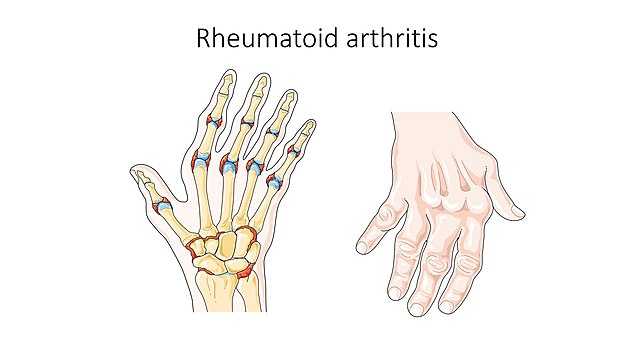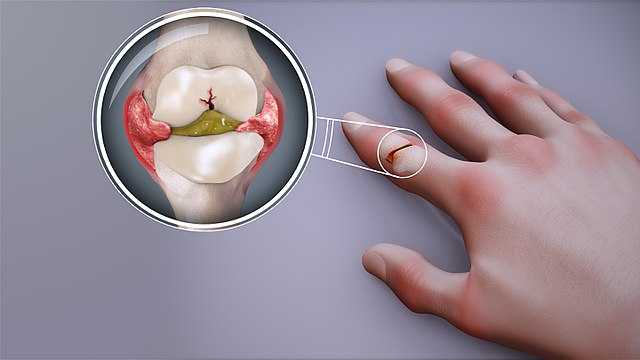[su_spoiler title=”Our Doctors Are Just A Few Steps Away!” open=”yes” style=”fancy” icon=”plus-square-2″][sc name=”article-query”][/su_spoiler]

Rheumatoid arthritis (RA) is an autoimmune disease that causes pain and damage in the joints throughout the body. Rheumatoid arthritis affects both sides of the body. It can also have an effect on different organs of the body like the skin, eyes, blood, lungs, heart, or nerves.
This is due to inflammation of the synovial membrane of the joint (membrane lining the joints). This can cause swelling, pain, decreased range of function, and movement of joints. It also causes joint damage and deformity of the joint.
Here’s how Rheumatoid arthritis affects different body parts:
1. Joints:
A) Hand and Wrist joint- Rheumatoid arthritis most commonly affects small joints of the hand and fingers. It causes joint damage and several types of hand deformity, such as:

• Rheumatoid nodules- Firm lump/nodes that develop under the skin near joints, commonly seen in 1/4th of the patients with RA.
• Joint effusion- Abnormal collection of fluid in or around the joint
• Joint stiffness- Feeling that mobility of joint is impaired or decreased
• Ulnar deviation- or ulnar drift, is a characteristic deformity in which all the fingers bend abnormally toward the little finger
• Contractures- Shortening or hardening of muscles and connective tissues of joint, leading to stiff or rigid joints and inability to move a joint through its full range of movement.
B) Hip joint- When rheumatoid arthritis starts to affect the weight-bearing joints—the hips, knees, and ankles—it can have a huge impact on mobility.
Specific symptoms of rheumatoid arthritis in the hips include:
• Aching pain or discomfort in the groin, outer thigh, or hips, worse after sitting or sleeping but improves with activity
• Swelling of joint
• Stiffness with decreased mobility of joint
C) Knee joint- The knee joint is the largest and strongest weight-bearing joint of the body. When the knee joint is damaged by rheumatoid arthritis, the pain, swelling, and stiffness may be severe.
Other symptoms may include:
• Difficulty in bending or straightening the knee
• Noises from joints on walking
• Weakness
D) Ankle and foot joint- Rheumatoid arthritis in the foot commonly causes pain, swelling, and stiffness with restrict the joint’s mobility and impair a person’s ability to walk, stand, or difficulty wearing shoes.
• The joint may be warm. One may develop bunions, and toes can begin to curl and stiffen in positions called claw toes.
• If the back of the foot and ankle are affected, the bones may shift position. This may cause the arch on the bottom of your foot to collapse (flat foot), leading to difficulty in walking.
2. Skin:
• Rheumatic Nodules: It is the most commonly seen skin manifestation. They are firm lumps that develop under the skin, over bony areas exposed to pressure, such as fingers, elbow, or ankle.
• Rashes: Rheumatoid vasculitis is a rare skin manifestation of rheumatoid arthritis, which is the inflammation of the small and medium-sized blood vessels, leading to a rash of small red dots, as a result. In severe cases, skin ulcers on the legs or under the nails can also appear.
3. Eye:
• Dry eyes- It is a common condition in which the eyes do not produce adequate tears, leading to redness, feeling of dryness, grittiness and, irritation.
• Scleritis- It is an inflammation of the sclera, or white portion of the eye. Symptoms of scleritis include redness, pain, blurred vision, and sensitivity to light.
• Uveitis- In rare cases, it can lead to uveitis, which is an inflammatory condition that affects the uvea, or inner portion of the eye.
4. Mouth:
• Dryness of mouth- Inflammation due to rheumatoid arthritis can damage the saliva-producing glands of the mouth as well as the eyes, resulting in a dry mouth.
Also Read: Rheumatoid Arthritis
5. Bones:
• Bone erosion- Chronic inflammation from RA leads to decreased bone density throughout the body, leading to thin and brittle bones. Exercise, a high-calcium diet, and vitamin D can be helpful in such cases.
6. Lungs:
• Inflammation and scarring- Lung involvement is seen in up to 80 percent of people with rheumatoid arthritis. Long-term inflammation of lung tissue can lead to scarring, that interferes with breathing with a chronic dry cough, fatigue, weakness, and loss of appetite.
• Lung Nodules- Rheumatoid nodules might form in the lungs, as well as in other parts of the body. Lung nodules usually do not cause any sign or symptom.
• Pleural disease- Inflammation of the layer surrounding the lung (known as pleura) accompanied by a buildup of fluid between two layers of the pleura (pleural effusion), can also occur in rare cases.
7. Heart and Blood Vessels:
• Inflammation and Atherosclerosis- Rheumatoid arthritis causes widespread inflammation thorough-out the body along with the joints. Long-lasting inflammation can damage the arteries with the development of plaque—a buildup of cholesterol, fat, calcium, and other substances in the blood. Gradually, plaque hardens and narrows the arteries, limiting the flow of oxygen-rich blood.
• Heart attack and stroke- When plaques from damaged blood vessels break, they can block another vessel, leading to a heart attack or stroke. So, the risk of heart attack is 50 percent more seen in patients with rheumatoid arthritis. Bacterial infection, rheumatic fever can also cause rheumatoid arthritis and thus heart damage.
• Pericarditis- In some cases, inflammation of the heart lining (known as pericardium), may manifest as chest pain. Chronic rheumatoid arthritis inflammation may cause long-lasting pericarditis.
8. Blood:
• Anemia- Rheumatoid arthritis increases the risk of anemia, as severe inflammation can lead to a reduction in red blood cells characterized by headache and fatigue.
• Blood clots- Inflammation may cause elevated blood platelet levels, and thus, makes the body more prone to increased blood clot formation.
Also Read: Juvenile Rheumatoid Arthritis
For more information, you can visit WebMD and HealthLine.
Rheumatoid Arthritis – Effects on Body
[su_divider top=”yes” style=”double” divider_color=”#952524″ link_color=”#952524″ size=”2″ margin=”10″]
[su_service title=”Also Read” icon=”icon: hand-o-right” icon_color=”#952524″]
[su_row][su_column size=”1/2″ center=”no” ][su_posts template=”templates/teaser-loop.php” id=”3890, 2652″ posts_per_page=”2″ post_type=”article” order=”desc”][/su_column]
[su_column size=”1/2″ center=”no” ][su_posts template=”templates/teaser-loop.php” id=”10447, 11974″ posts_per_page=”2″ post_type=”article” order=”desc”][/su_column]
[/su_row]
[/su_service]
[sc name=”know-your-doctor”]
[sc name=”more-links-articles”]

